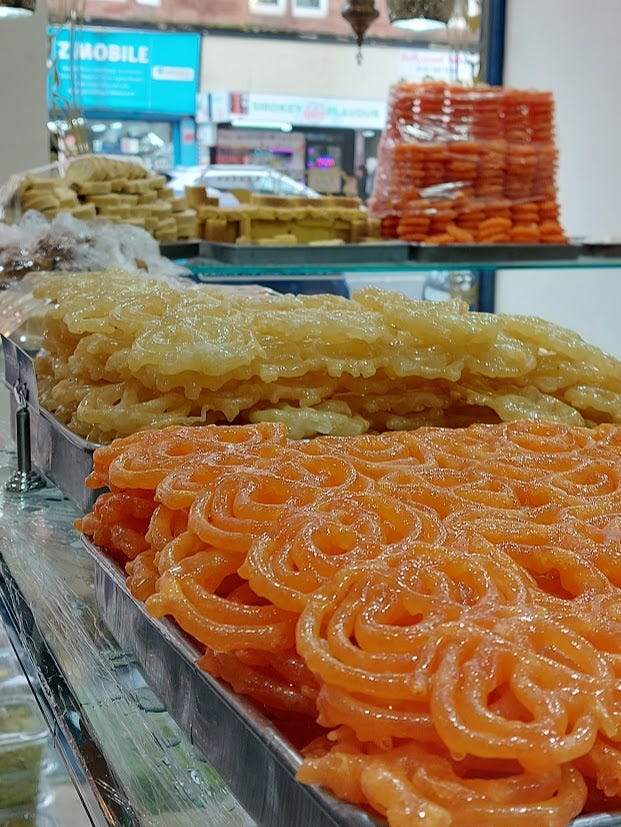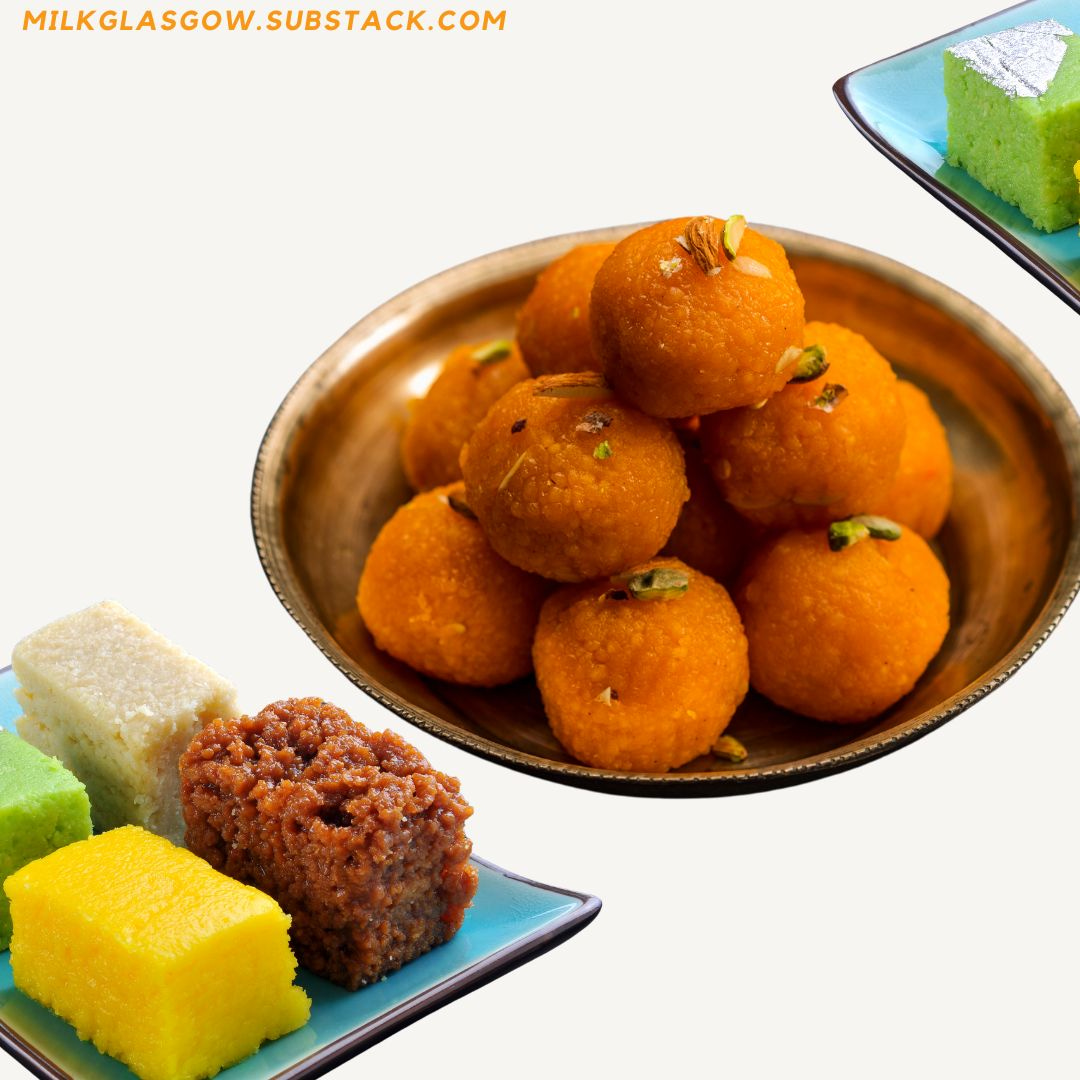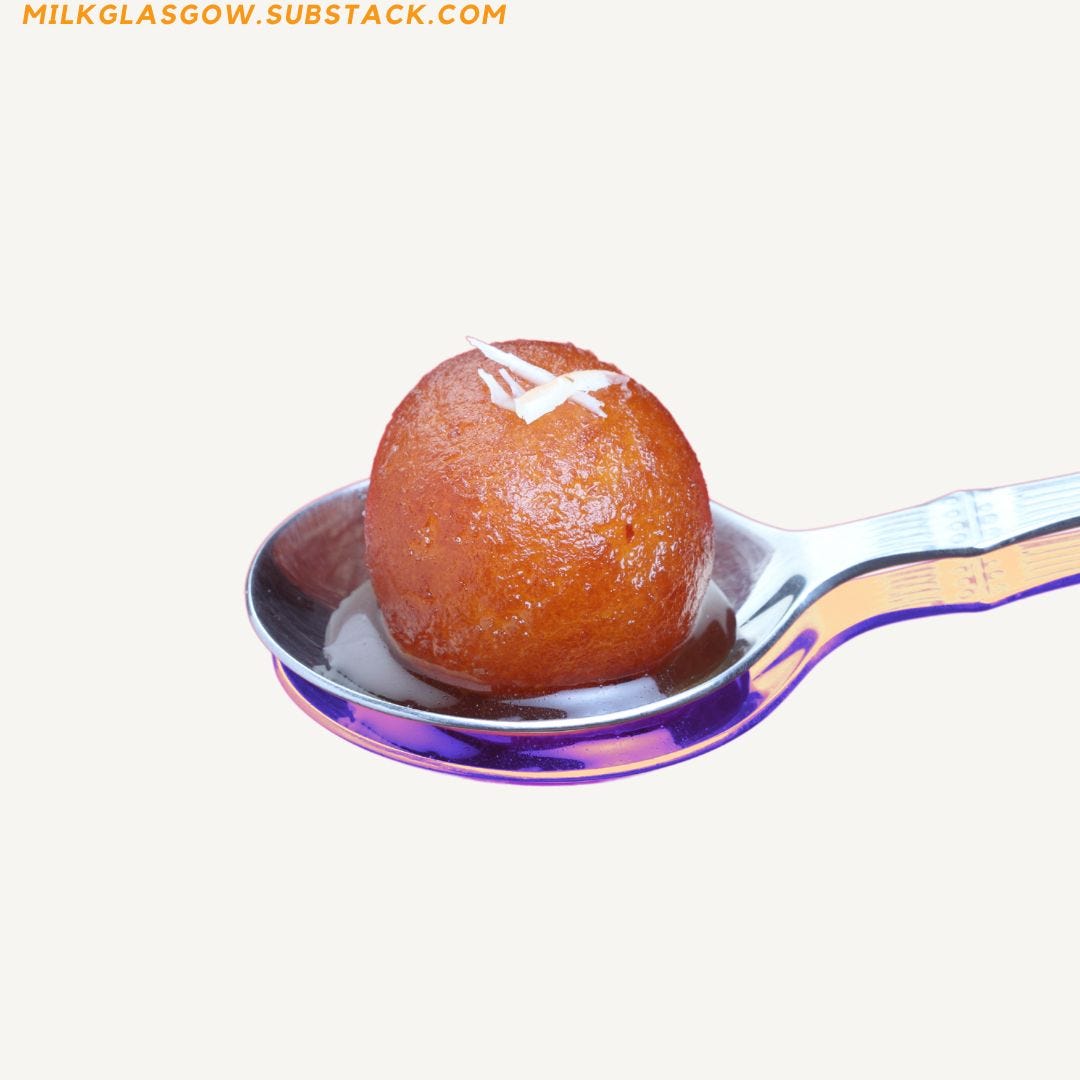A Guide to Meetha: Our Favourite South Asian Sweets Shop in Govanhill
Written by Shakya Seresinghe
Note from Shakya,
I mentioned on Tuesday that I’d share the sign-up form for the film night; unfortunately, this won’t be available until next Tuesday—I need to sort out few things beforehand. Sorry for any inconvenience!
In the meantime, I hope you all enjoy this Friday’s article about our favourite South Asian sweet shop in the South Side. Doing the final edits for this is making me very hungry, so I might run to Kündun for a veg samosa and a Gulab Jamun!
Have a lovely weekend!
A Guide to Meetha: Our Favourite South Asian Sweet Shop in Govanhill and Histories of Movement
Written by Shakya Seresinghe
Meetha means ‘sweets’ in Urdu, a term I learned from a friend back in high school. On some evenings, after school, I’d go to her house, and we’d sit together to watch TV while eating loads of snacks and fizzy drinks her mum offered. Being Gujarati, there would always be a Bollywood film playing on her TV, and we’d watch it, mostly without subtitles. Somehow, I managed to grasp the words and their meanings over time.
If you’ve ever watched a Bollywood film, especially from the 80s and 90s, you'd know that on special occasions like an announcement of an engagement or pregnancy, there’s always the roar "muh meetha karo!" which means "sweeten your mouth", often shouted by the father figure. He’d carry a box of laddu and forcefully feed everyone he comes across. That’s how we mark special occasions in the subcontinent, by having meetha, something sweet.
Meetha is quite different from the cakes, pastries, and various kinds of sweets you’d find in Europe. They are incredibly rich, made of flour, including various types such as semolina, gram flour/chickpea flour, and corn flour. They also often consist of milk, ghee, and sugar, spiced with cinnamon, cardamom, and cloves, and often contain nuts like pistachios, cashews, and almonds. They also come in various colours and shapes—sometimes squares, balls, stars, swirls, or diamond-shaped. Some are dry, some are dipped in syrup, some are very sticky, and some are crumbly. Meetha shops are always a sight to see.
Navigating meetha shops can be quite overwhelming, especially if you're not familiar with the sweets from the subcontinent. Some sweets are labelled, while others are not, so you really have to know your way around to make the best selections.
When I stumbled upon Kündun during my first week at MILK, it felt like I had hit the jackpot. However, I felt incredibly shy and kept ordering the same thing I knew, afraid to try out new things.
When Omaira, Naaz, and I walked in for a quick research visit months later to write this piece, the uncle we met—let's call him Kündun uncle—was very welcoming. He told us loads of information about the meetha in Kündun, he especially mentioned that they were made with 'mehenath', effort. Many of the sweets are made with high-quality ghee, and you can really taste the difference. Kündun's uncle also shared a wealth of information about the history of meetha and let us taste everything!
Omaira’s favourite Sohan Halwa
For instance, Omaira's favourite is Sohan Halwa. Sohan Halwa has a long history, tracing all the way to Multan, a city located in the southern part of Punjab. Legend has it that a chap called Sohan Ram, a milk seller in Multan accidentally ended up making halwa after boiling a large quantity of milk for a bit too long. There are other theories, one of which suggests that Sohan, a popular sweet in Persia, travelled to Pakistan through ancient trading routes. It is made with cornflour, sugar, milk, and ghee, with pistachios, cardamom, and a bit of saffron.
Motichoor laddu and Barfi
My favourites are Motichoor Laddu, a ball made with tiny pearls of boondi, consisting of gram flour, sugar syrup, and made using a special strainer called boondi jhara. It's very sweet and crumbly.
My second favourite is Barfi, a fudge-like meetha made with milk or condensed milk. It has a long history dating back to the 14th century. Barfi comes in many flavours. At Kündun, you can find milk, almond, pistachio (my favourite), and newer versions like Belgian chocolate. I've heard from Omaira that in some shops, you can find weirder varieties of barfi like Irn-Bru and Coke.
Gulab Jamun
Gulab Jamun is made by heating milk until the water evaporates, leaving khoya. It’s then kneaded with flour, sometimes semolina, and shaped into small dough balls, which are then deep-fried in oil or ghee and soaked in a sugar syrup with cardamom and rose water. Of course, there are variations to this, but this is my overall take on Gulab Jamun. There’s a version of this in Trinidad and Tobago called Trinidad Gulab Jamoon or Fat Kurma, a slightly different version that originates from Indo-Trinidadians and Tobagonians, whose ancestors were brought over to Trinidad from the subcontinent as indentured laborers by British colonialists.
Ras Malai and Jalebi are also favourites for many.
The meetha you find in Kündun are products of rich histories of movement. From Persia to the subcontinent and vice versa, from there to the Caribbean and Europe. Meetha, too, has travelled across continents and seas with people, evolving and taking on newer, different forms and identities, just as the people who make and consume it have.
My attachment to meetha is also a product of movement. Having moved to the UK from Sri Lanka, where Sri Lankan things are not readily available, I find familiarity with things from elsewhere in the subcontinent. Living in the UK, we leave behind our diverse cultures and identities and are often categorised into homogenous identities like 'brown' or 'South Asian'. Embracing these labels means finding familiarity in scents and tastes from elsewhere. So, when I eat meetha, it doesn't necessarily help me connect with my Sri Lankan roots, but it does help me embrace my otherness.
Meetha is central to our lives, and we are very lucky to have this special meetha shop, Kündun, right by our doorstep. I'd say, next time you're around Victoria Street, stop by and give it a go.
Today’s article is written by Shakya. They work for MILK.
Kim Supajirawatananon and Shakya Seresinghe act as the overall contributors for the blog, pitching article ideas, putting together articles, posting, and making small edits. We also run a peer-writers project on the side, where creatives from the wider community support the blog through editing, interpreting, translating etc. This blog is a collective effort, and we thank everyone for their contributions.
All our content is free. If you can, we ask you to consider making a small pledge so we can compensate the contributors in small ways.
Thank you very much.









Getting hungry reading this